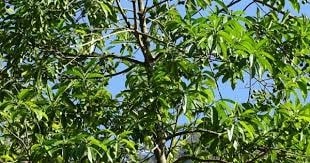Elaeocarpus ganitrus (रुद्राक्ष वृक्ष)
Scientific Name: Elaeocarpus ganitrus
Common Names: Rudraksha, stonefruit

Description: 35 out of the 300 species of Elaeocarpus are found in India. The principal species of this genus is Elaeocarpus ganitrus, which is commonly known as "rudraksha tree", and is found in Gangetic plain, in the foothills of the Himalayas, parts of Australia, Guam and Hawaii.
Importance: Rudraksha fruits contain alkaloids, flavonoids, tannins, steroids, triterpenes, and cardiac glycosides. They also contain rudrakine an alkaloid which had been discovered in rudraksha fruit. The dried stones are used as prayer beads by Hindus, as well as by Buddhists, Sikhs and Muslims. When they are ripe, rudraksha stones are covered by an inedible blue outer fruit so they are sometimes called "blueberry beads."
Type: Evergreen
Family: Elaeocarpus
Parts used: Fruit
Location: Nectar Garden
Other Plants
Scientific Name: Elaeocarpus ganitrus
Common Names: Rudraksha, stonefruit

Type: Evergreen
Family: Elaeocarpus
Parts used: Fruit
Description: 35 out of the 300 species of Elaeocarpus are found in India. The principal species of this genus is Elaeocarpus ganitrus, which is commonly known as "rudraksha tree", and is found in Gangetic plain, in the foothills of the Himalayas, parts of Australia, Guam and Hawaii.
Importance: Rudraksha fruits contain alkaloids, flavonoids, tannins, steroids, triterpenes, and cardiac glycosides. They also contain rudrakine an alkaloid which had been discovered in rudraksha fruit. The dried stones are used as prayer beads by Hindus, as well as by Buddhists, Sikhs and Muslims. When they are ripe, rudraksha stones are covered by an inedible blue outer fruit so they are sometimes called "blueberry beads."
Location: Nectar Garden